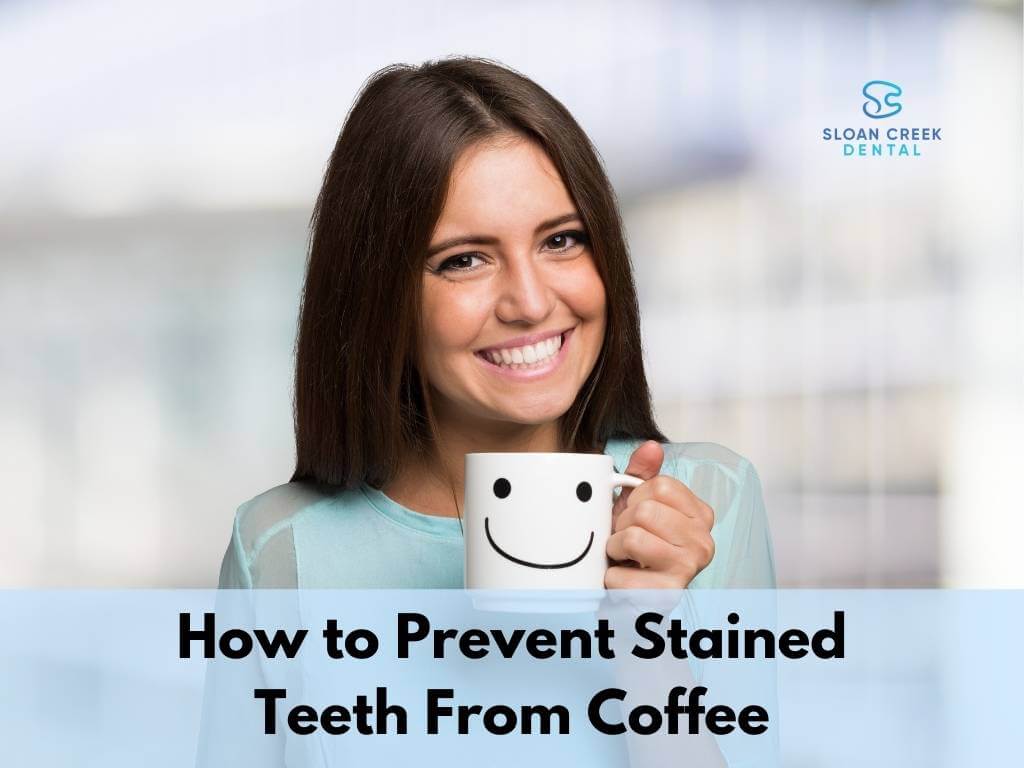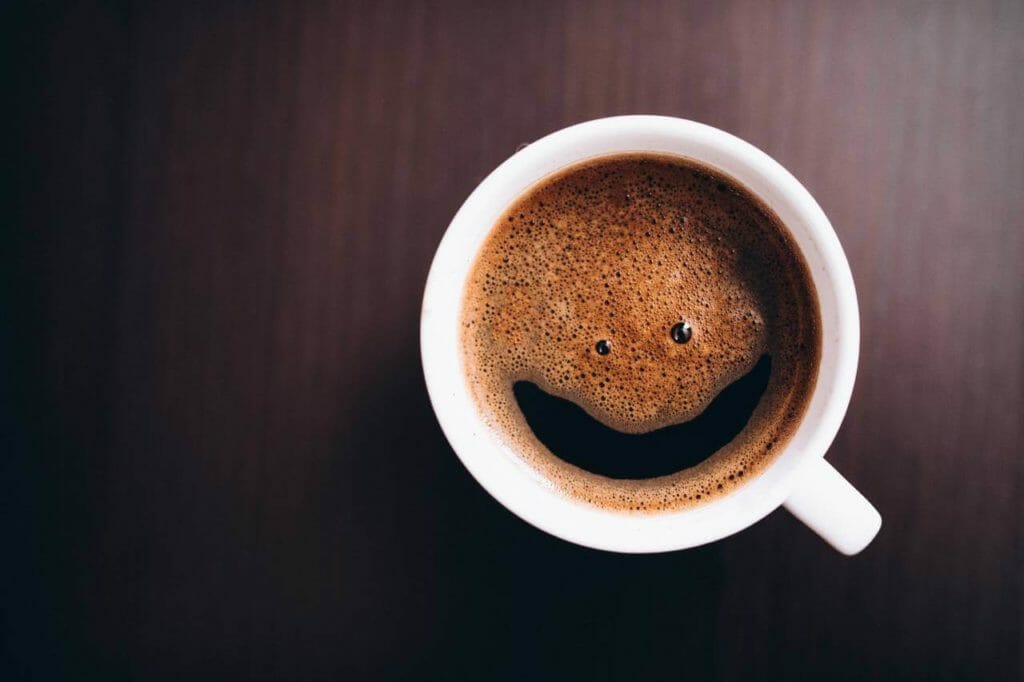
A smile is important. When you have teeth that are stained from years of coffee drinking, it can be hard to smile freely. It may make you lose confidence in your smile and feel self-conscious about your teeth. If you want to whiten your teeth and smile confidently again, there are many options available to you. Perhaps you’d prefer a professional dental service, such as laser teeth whitening. Or maybe you’re more interested in a do-it-yourself (DIY) option, like teeth whitening strips. There’s no wrong path; the important thing is that if you’re unhappy about the coffee stains on your teeth, here are some ways you can prevent them, and there are options for you to brighten up your smile.
Coffee is one of the most popular drinks in the world—and with good reason. It’s a delicious and energizing treat enjoyed by millions of people each day. However, it does have one notable drawback: it can stain your teeth.
When you drink coffee, your teeth come in contact with an organic compound called tannins. Tannins are a natural plant compound with acidic proprieties found in many fruits, vegetables, and drinks like wine and black tea. When the tannins come into contact with your teeth, it reacts with the calcium in the enamel to cause a chemical reaction that darkens your teeth to a yellowish color.

Coffee is a popular hot beverage that many people enjoy. However, coffee can have a negative effect on your oral health. In fact, many people do not realize that coffee can stain teeth, erode tooth enamel, and cause other problems.
When you eat and drink acidic foods and drinks, your teeth are exposed to an acidic environment. This can cause enamel to wear down and lead to tooth decay. The high temperature of coffee can also cause damage to your teeth. This is because hot drinks can actually cause enamel erosion making you more sensitive to hot and cold foods.

You can do some things to keep your teeth looking bright and white for as long as possible. Here are some of the most effective ways to prevent tooth discoloration.
A healthy smile is a beautiful smile. Getting into the habit of practicing good oral hygiene like brushing and flossing your teeth, is one of the most important things to keep your smile looking its best. It helps prevent tooth decay and cavities, and it’s also a vital component of keeping coffee stains off your teeth.
Electric toothbrushes are more effective than manual ones because they:
If you’re frequently on the go, it can be challenging to find time to brush your teeth. In this situation, rinsing water around your mouth is a quick and easy way to help keep your teeth stain-free after a cup of coffee.
When you eat, your saliva is activated and starts washing away the tannins from your coffee. A healthy fruit or vegetable is an excellent snack to help prevent these stains. Apples, pears, celery, and cucumbers are all great options for this purpose. These types of foods will not only be beneficial for your overall health; they actively prevent coffee stains on your teeth.
Drink your coffee through a straw to protect your teeth and avoid the yellow stains that can come with sipping hot beverages. This is because the coffee never has a chance to directly stain your teeth when it’s being sipped through a straw. If you’re an ice coffee drinker, this approach should be intuitive, but it’s also applicable to hot coffee.
Dentists recommend checkups at least once every six months to prevent problems before developing. During your six-month cleaning appointment, your dentist can recommend ways that you can keep your teeth looking healthy.
If you’ve seen the effects of coffee, tea, or wine on your teeth and want to brighten up that smile, fear not! Here are some ideas to restore your smile.
Two of the most common options for over-the-counter teeth whitening are bleach strips and whitening toothpaste.
Bleach strips are a type of thin, plastic strip that is coated with a peroxide-based bleaching agent. The strips are applied to teeth for a short period of time on a regular basis, and work by slowly breaking down stains and whitening the enamel.
Whitening toothpaste contains hydrogen peroxide, baking soda, or other ingredients that help clean and brighten the surface of teeth to remove surface stains.
Over-the-counter whitening products are easily accessible and affordable, making them a go-to option for many people. These products can be found in most drug stores, grocery stores, and online retailers.
For those who’d like a stronger and faster whitening solution, you can always get your teeth professionally whitened. There are three popular professional options: Zoom teeth whitening, laser teeth whitening and take-home trays.
Zoom teeth whitening – Zoom is an in-office tooth whitening procedure that uses an advanced chairside lamp, that activates the 25 percent hydrogen peroxide gel, and accelerates the bleaching process for a brighter smile. With Zoom! it whitens discolored enamel, eliminates stains, and can be completed in just one hour.
Laser teeth whitening – Depending on your local dentist, they may use a different type of laser teeth whitening system. At Sloan Creek Dental, we use Fotona’s patented TouchWhite™ Tooth Whitening system. The TouchWhite™ system is performed by using the most advanced laser on the market called the Lightwalker by Fotona. What sets the Lightwalker apart is its modern approach to laser dentistry and versatility for us to offer several laser dental procedures to our patients. The Lightwalker laser is contact-free, so patients are said to feel no vibrations or pain, which makes getting any dental treatment done very comfortable for you. The Lightwalker dental laser is twice as efficient and advanced as other whitening treatments. The average treatment lasts 45-60 minutes, making it easy to fit into anyone’s schedule—even during a lunch break!
Take-home trays – Take-home whitening trays can be made for both the upper and lower sets of your teeth. With these trays, you can safely and effectively whiten your teeth at your convenience. The trays are custom-fitted to your teeth, so they are more comfortable than over-the-counter options. You will also receive comprehensive instructions on using the trays and how much of the professional-grade whitening gel to use.
You don’t have to give up your morning cup of hot coffee to keep a healthy, white smile. Coffee is rich in polyphenols, which can help protect teeth from damage—but only when enjoyed in moderation. We recommend no more than two cups of coffee a day, plus regular brushing and regular visits to your local family dentist.
In general, tea has more acid and tannins than coffee, which can cause staining on the surface of your teeth. This means that the darker you go with your tea, the more likely it is to stain your teeth.
Stains on teeth from coffee or tea will not go away by themselves. However, when properly treated with a dental cleaning and teeth whitening, enamel stains can be removed or lightened.
Extrinsic stain – Such as those from coffee – are outside the tooth’s layer of enamel and require a different approach to remove them than intrinsic stains.
Intrinsic stain – Intrinsic tooth stains are discolorations on the inner layer of teeth, where dentin is found.

A morning coffee is one of life’s little joys for many people. If you think you need to brighten up your smile with professional teeth whitening or would like a regular cleaning, our team would love to help you achieve the smile of your dreams. We’re here to answer all of your treatment option questions to find the right dental solution for you.
To schedule your in-person consultation, contact Sloan Creek Dental, and our friendly staff will be happy to assist you. You can reach us at our Fairview, TX dental office to schedule an in-person consultation with us today – 972-468-1440.
Our dental office is located in Fairview, Texas, and our patients visit us from across the surrounding areas, including Allen, Plano, McKinney, and Lucas.
We firmly believe that the internet should be available and accessible to anyone, and are committed to providing a website that is accessible to the widest possible audience, regardless of circumstance and ability.
To fulfill this, we aim to adhere as strictly as possible to the World Wide Web Consortium’s (W3C) Web Content Accessibility Guidelines 2.1 (WCAG 2.1) at the AA level. These guidelines explain how to make web content accessible to people with a wide array of disabilities. Complying with those guidelines helps us ensure that the website is accessible to all people: blind people, people with motor impairments, visual impairment, cognitive disabilities, and more.
This website utilizes various technologies that are meant to make it as accessible as possible at all times. We utilize an accessibility interface that allows persons with specific disabilities to adjust the website’s UI (user interface) and design it to their personal needs.
Additionally, the website utilizes an AI-based application that runs in the background and optimizes its accessibility level constantly. This application remediates the website’s HTML, adapts Its functionality and behavior for screen-readers used by the blind users, and for keyboard functions used by individuals with motor impairments.
If you’ve found a malfunction or have ideas for improvement, we’ll be happy to hear from you. You can reach out to the website’s operators by using the following email
Our website implements the ARIA attributes (Accessible Rich Internet Applications) technique, alongside various different behavioral changes, to ensure blind users visiting with screen-readers are able to read, comprehend, and enjoy the website’s functions. As soon as a user with a screen-reader enters your site, they immediately receive a prompt to enter the Screen-Reader Profile so they can browse and operate your site effectively. Here’s how our website covers some of the most important screen-reader requirements, alongside console screenshots of code examples:
Screen-reader optimization: we run a background process that learns the website’s components from top to bottom, to ensure ongoing compliance even when updating the website. In this process, we provide screen-readers with meaningful data using the ARIA set of attributes. For example, we provide accurate form labels; descriptions for actionable icons (social media icons, search icons, cart icons, etc.); validation guidance for form inputs; element roles such as buttons, menus, modal dialogues (popups), and others. Additionally, the background process scans all of the website’s images and provides an accurate and meaningful image-object-recognition-based description as an ALT (alternate text) tag for images that are not described. It will also extract texts that are embedded within the image, using an OCR (optical character recognition) technology. To turn on screen-reader adjustments at any time, users need only to press the Alt+1 keyboard combination. Screen-reader users also get automatic announcements to turn the Screen-reader mode on as soon as they enter the website.
These adjustments are compatible with all popular screen readers, including JAWS and NVDA.
Keyboard navigation optimization: The background process also adjusts the website’s HTML, and adds various behaviors using JavaScript code to make the website operable by the keyboard. This includes the ability to navigate the website using the Tab and Shift+Tab keys, operate dropdowns with the arrow keys, close them with Esc, trigger buttons and links using the Enter key, navigate between radio and checkbox elements using the arrow keys, and fill them in with the Spacebar or Enter key.Additionally, keyboard users will find quick-navigation and content-skip menus, available at any time by clicking Alt+1, or as the first elements of the site while navigating with the keyboard. The background process also handles triggered popups by moving the keyboard focus towards them as soon as they appear, and not allow the focus drift outside of it.
Users can also use shortcuts such as “M” (menus), “H” (headings), “F” (forms), “B” (buttons), and “G” (graphics) to jump to specific elements.
We aim to support the widest array of browsers and assistive technologies as possible, so our users can choose the best fitting tools for them, with as few limitations as possible. Therefore, we have worked very hard to be able to support all major systems that comprise over 95% of the user market share including Google Chrome, Mozilla Firefox, Apple Safari, Opera and Microsoft Edge, JAWS and NVDA (screen readers), both for Windows and for MAC users.
Despite our very best efforts to allow anybody to adjust the website to their needs, there may still be pages or sections that are not fully accessible, are in the process of becoming accessible, or are lacking an adequate technological solution to make them accessible. Still, we are continually improving our accessibility, adding, updating and improving its options and features, and developing and adopting new technologies. All this is meant to reach the optimal level of accessibility, following technological advancements. For any assistance, please reach out to